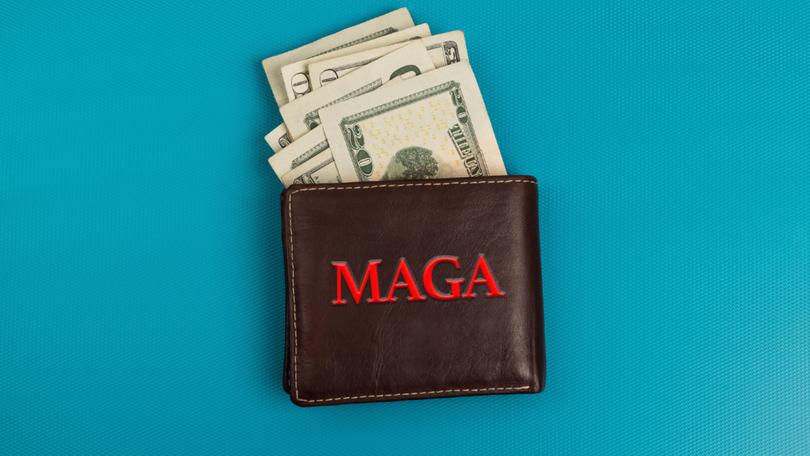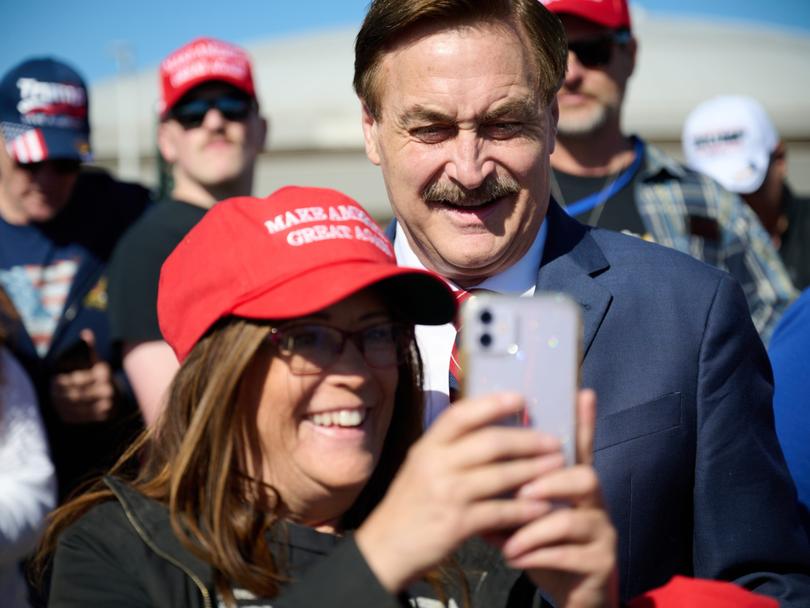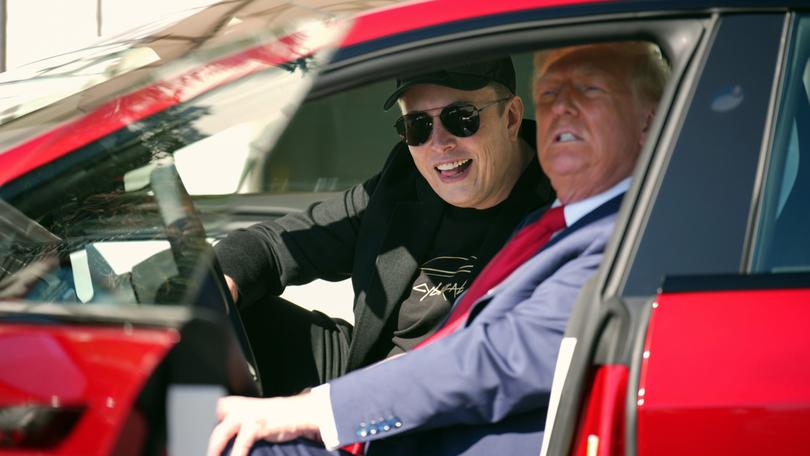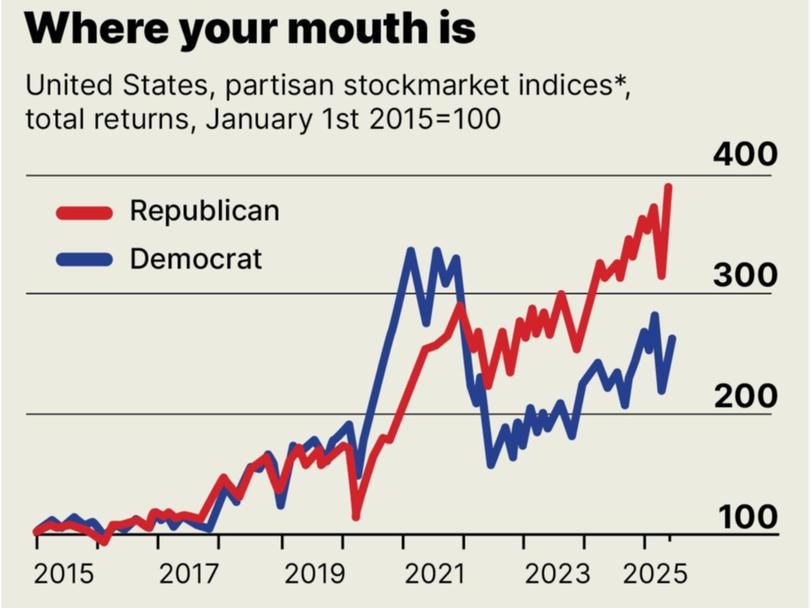THE ECONOMIST: Why the MAGA economy is thriving as politics Trumps wealth for American consumers

Imagine the perfect morning . . .
After sleeping between sheets from MyPillow — a company established by Mike Lindell, a conspiracy theorist — you drink some Black Rifle Coffee, which “serves coffee and culture to people who love America”.
You shave with Jeremy’s Razors (“built for rugged jawlines . . . not feelings”).
Sign up to The Nightly's newsletters.
Get the first look at the digital newspaper, curated daily stories and breaking headlines delivered to your inbox.
By continuing you agree to our Terms and Privacy Policy.Then you eat some bacon from Good Ranchers, which pledges to “make the American farm strong again”, before going for a spin on your Harley-Davidson.
The broader MAGA universe extends beyond goods with over-the-top marketing to products and employers merely favoured by Republicans. And each economic choice adds up to something bigger.
According to our analysis, America is splitting into two different economies and markets: one conservative, the other liberal.
People on each side think about the economy differently, they buy different things and work in increasingly different industries.
Not only that: the MAGA economy is doing surprisingly well. American liberals tend to look down on companies that market themselves to conservatives.
Although this is in part because they do not like the opposing side, some MAGA products look like scams.
President Donald Trump’s crypto coin soared following its launch, only to crash quickly and leave many supporters holding the bag.

His branded watches, including the “Fight Fight Fight” model, cost up to $US100,000 ($154,000) and have received mixed reviews.
Such snobbery also reflects a belief that the conservative economy is backward.
Hillary Clinton, the Democratic presidential nominee in 2016, noted she had “won the places that represent two-thirds of America’s gross domestic product . . places that are optimistic, diverse, dynamic, moving forward”. Kamala Harris, the nominee in 2024, won a similar share of GDP.
Of course, some solidly Republican districts have long been rich.
In Jupiter, a town in Florida, local activities include playing golf and wearing white chinos.
Yet Yuba City, in northern California, where lots of locals are farmers and people voted strongly for Mr Trump, may be more illustrative of MAGA-land.
Incomes are low; shops sell hardware, guns and fast food. There are no chinos in sight.
Despite this, the association of Republicanism with backwardness has run ahead of the data.
Even places like Yuba City are doing better than before and together MAGA-land is enormously powerful.
If Democrats have two-thirds of American GDP, that still leaves Republicans with around $US10trillion — making them the world’s third-largest economy.
And as anyone who has watched Friday Night Lights will know, all parts of America have big spenders. Buddy Garrity, a car dealer, is the archetypal MAGA rich guy. He is not wealthy enough to own a private jet or plugged-in enough to attend the Met Gala; still, he has plenty in the bank.
The growing gap between the MAGA and Democratic economies can be seen in both “soft” and “hard” data.
Surveys suggest that Democrats and Republicans now live in two different realities.
Before the presidential election 50 per cent of Democrats believed that the economy was getting better, against just 6 per cent of Republicans.
Today 8 per cent of Democrats and 49 per cent of Republicans respond in the same way.
Such partisanship has become more pronounced. Look, for instance, at the gap in inflation expectations by party. “Hard” data tell a similar story

According to a recent paper by Verena Schoenmueller of Esade University and colleagues, residents of each economy consume in increasingly different ways.
After Mr Trump’s election victory in 2016, “liberals faced a threat to their political identity . . . which they possibly compensated for by stronger support for liberal-oriented brands” — buying more Patagonia fleeces, perhaps.
TD Cowen, an investment bank, has forecast that Elon Musk’s alliance with Mr Trump will reduce Tesla sales by over 100,000 vehicles a year in Democratic-leaning counties, while boosting sales by twice as much in Republican ones.
Official data also suggest that consumer tastes are splitting along partisan lines.
Compare New York, a blue state, with Wyoming, a red one.
Since the 1990s blue people have spent more on stereotypical blue goods and services, and red people more on red.
New Yorkers have splurged on dining out. They have also jacked up spending on public transport.
People in the Equality State, by contrast, spend more than they did on things you might associate with an older, more conservative population, such as vehicle parts and nursing homes.
It is not just consumption. MAGA and blue economies are behaving increasingly differently, too.
They reacted in different ways to the first wave of COVID-19.
Economic activity in red states, where locals were not so afraid of the virus, fell by half as much as in blue ones. This divergence was the culmination of a long-term trend.
The variance in GDP-growth rates, between Democratic and Republican counties, widened sharply around 2008. It has remained about twice as high ever since.
In the olden days, when a red place was doing well, you could be pretty sure that a blue place would also be thriving. No longer.
The two economies are behaving differently since their industrial compositions are changing.
We have analysed data on employment and pay across counties. Over time, places that voted Democratic in 2024 have taken a greater share of knowledge-intensive forms of economic activity.
In 1993 roughly the same share of employee compensation came from the “information” sector, comprising software and the like, in Republican counties as elsewhere.
Now the share is 30 per cent lower than average, while dependence on manufacturing has risen.
All told, employment patterns in the Democratic and Republican economies have diverged by 20 per cent, according to difference between “location quotients”, a measure of job dispersion by industry.
Buddy up
There are more Buddy Garritys today, too. In 2024, 47 per cent of Americans reporting annual incomes above $US1m lived in Trump-voting states, up from 43 per cent in 2014.
The MAGA economy has lots of big businesses that liberals rarely encounter.
Yuba City is home to WinCo, which feels like a knock-off Costco; Boot Barn, which sells cowboy boots; and Hobby Lobby, an arts-and-crafts retailer. All seem to be doing well.
Fox News’s viewers may be on the poorer side, yet over the past year the company’s share price has been on a tear.
Olive Garden, an Italian restaurant chain, is another example found in Yuba City. According to a YouGov the dining option most favoured by Republicans, relative to Democrats, behind Cracker Barrel, which offers wooden rocking chairs and Southern cuisine.
The share price of Darden, which runs the chain, has nearly tripled in the past five years.
These trends play out across America.
Along with Kai Wu of Sparkline Capital, a fund manager, we assembled 30 listed firms that are seen favourably by Republicans or Democrats, based on surveys as there is no single poll that covers all companies.
In the end, the Republican basket included firms such as John Deere, Fox and Harley-Davidson, whereas the Democratic one featured Etsy, Lululemon, Lyft and more. The recent market turmoil hit the Republican basket hard.
But in the past decade its shareholder returns, including dividends, have thrashed the blue basket.

Why do MAGA companies seem to outperform? Maybe they eschew virtue-signalling.
Point Bridge America First, an exchange-traded fund that uses the stock ticker MAGA, only includes firms that support Republicans.
The Democratic Large-Cap Core Fund, with the stock ticker DEMZ, invests in companies that make big donations to the Democrats.
Since the end of 2020 MAGA’s price has easily outperformed DEMZ.
Goldman Sachs, a bank, has built a stock index containing firms “that could benefit from key Republican policies”, such as those in oil.
In the past decade the share prices of these companies have comfortably beaten the market.
The future for the MAGA economy is uncertain. By raising the cost of imported components, tariffs will hurt manufacturing.
Harley-Davidson is a soft target for foreign politicians looking to retaliate.
On the flip side, however, Republican states including Florida and Texas are still enticing internal migrants.
And with local consumer confidence strong, expect spending in MAGA-land to hold up better than in Democratic-leaning areas. It does not just rely on MyPillow.
Originally published as Why the MAGA economy is thriving
